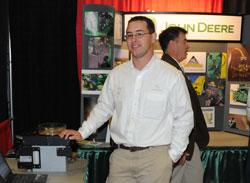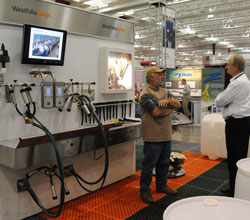According to a story from the Cleantech Group, researchers have found a way to harness electricity from trees and this has an agricultural application.
Boston, Mass.-based Massachusetts Institute of Technology (MIT) researchers said this week they’ve engineered a way to use the natural power generated by trees to recharge battery operated sensors that can detect forest fires.
The development figures prominently in an emerging field of technology in which wireless sensors, monitoring devices and novel uses of biological systems for agriculture are being put to use to save resources and improve growth in plants.
The MIT researchers are not alone in their innovative efforts. Several other new startups and university projects are underway in the area of precision agriculture.
In simple terms, precision agriculture is devoted to applying technology to better manage use of water and other natural resources to improve agricultural production. To date, the private sector has made a significant investment to tailor information technologies for agricultural applications, according to experts.
The other potential sensor applications for agriculture and vineyards include optimizing the use and timing of fertilizer application as well as early warning for frost and excessive heat and prediction of the potential for disease and pest outbreaks.
Some of the other wireless-sensor startups in the area of precision agricultural include Grape Networks and Fruition Sciences. Both are focused on the high end of the winery market.
 This week I’ll be “Driving Green” in the south as John Deere unveils the latest in small tractors, compact tractors, utility vehicles and more.
This week I’ll be “Driving Green” in the south as John Deere unveils the latest in small tractors, compact tractors, utility vehicles and more.
 One of the ways dairy farmers are using precision agriculture is in the area of forage production. It allows them to measure the moisture in it very precisely?
One of the ways dairy farmers are using precision agriculture is in the area of forage production. It allows them to measure the moisture in it very precisely?  You don’t usually think of precision agriculture when it comes to the dairy industry. However, I heard it this morning in a press conference for
You don’t usually think of precision agriculture when it comes to the dairy industry. However, I heard it this morning in a press conference for  Besides subscribing to the RSS feed of Precision.AgWired.com we’ve now got another option for you. Precision.AgWired.com has its own
Besides subscribing to the RSS feed of Precision.AgWired.com we’ve now got another option for you. Precision.AgWired.com has its own  The
The  A new report from
A new report from  Indiana farm broadcaster Gary Truitt – voice of the Hoosier Ag Today radio network – recently did an interview with Purdue ag economist Bruce Erickson about how higher input costs are making many farmers take a second look at precision.
Indiana farm broadcaster Gary Truitt – voice of the Hoosier Ag Today radio network – recently did an interview with Purdue ag economist Bruce Erickson about how higher input costs are making many farmers take a second look at precision.  Erickson told Gary that the change in the farm economy has spurred a renewed interest in precision farming. “Couple of major things that drive precision technologies are saving input costs and increasing yields,” Bruce said. “With both higher input costs and high grain prices, we have the potential to make precision technologies more profitable.”
Erickson told Gary that the change in the farm economy has spurred a renewed interest in precision farming. “Couple of major things that drive precision technologies are saving input costs and increasing yields,” Bruce said. “With both higher input costs and high grain prices, we have the potential to make precision technologies more profitable.”